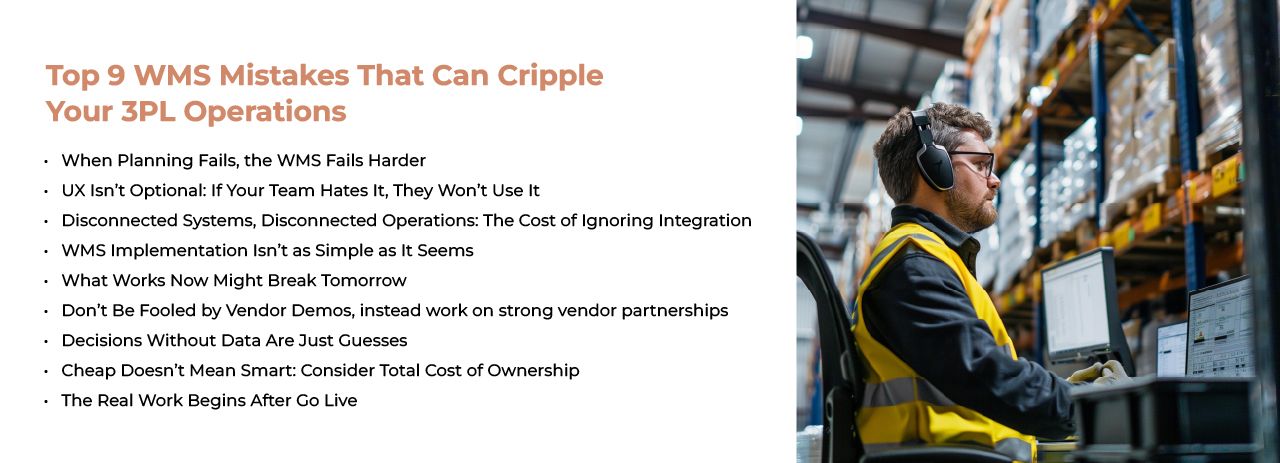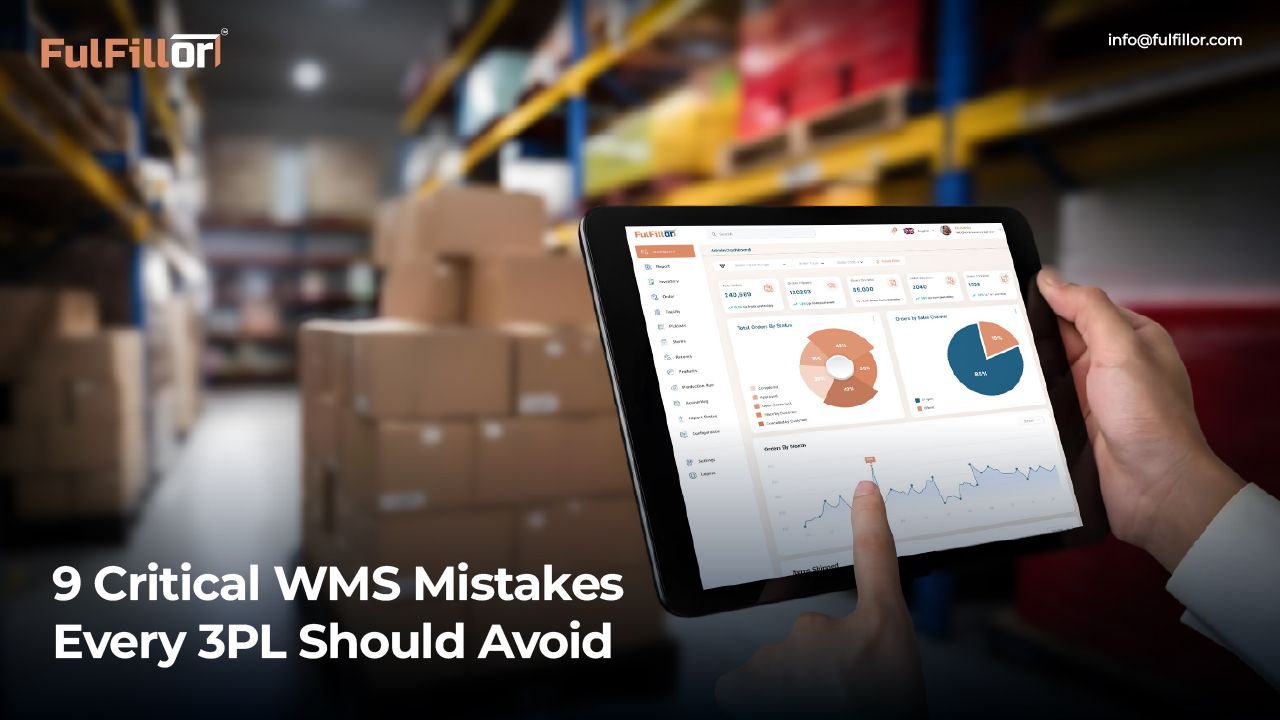WMS Mistakes in 3PL Operations: 9 Common Issues and Quick Fixes
Selecting the right warehouse management system (WMS) for 3PLs (Third-party Logistics) is quite challenging.
A survey by Logistics Management found that nearly 60% of WMS implementations experience delays or budget overruns largely due to avoidable mistakes in the selection and setup process. For a 3PL company, choosing the right warehouse management system (WMS) is vital for business success, enhancing customer satisfaction. But the real problem is: with the numerous choices available in today’s market, it is quite common to make some mistakes which can result in expensive missteps, operational nightmares, implementation headaches, or in the worst case scenario, it can also result in lost customers and revenue.
In this post, we'll discuss the top 9 WMS selection mistakes that no 3PL should make, and offer some tips to assist in making the right selection.
What Are the Top WMS Mistakes 3PLs Must Avoid to Stay Efficient?

1. Planning is Key: Why Skipping a Needs Assessment Wrecks Your 3PL WMS Strategy
A needs assessment should be done to determine your specific required attributes when choosing a 3PL WMS. Bypassing a rigorous needs assessment is the same as embarking on a road trip with no map. Many 3PLs are only concerned with what hurts now and forget to think about how the business may grow, what new services they could provide, or anticipate client demands. The result? You’re left with an outdated warehouse management system before you even finish onboarding.
Tip: Instead, collect information from every department - operations, IT, sales, even your pickers on the warehouse floor. Plan not only for what you need today, but also for what you will need tomorrow.
2. UX Isn’t Optional: If Your Team Hates It, They Won’t Use It
Even the best WMS for 3PL is pointless if your team can’t navigate how to use it. One of the common and critical warehouse software mistakes is overlooking the importance of user experience (UX) and in-depth training. A clumsy interface slows down productivity, and poor training underutilizes it.
Tip: Choose a 3PL WMS Software that is intuitive and user-friendly, not the other way around, and ensure that you are getting the best training and support possible from the vendor. Your team’s skills are critical to your success.
3. The Cost of Disconnected Systems: Why 3PLs Can’t Afford Poor System Integration in Their WMS
Your WMS isn’t going to be a standalone system. To overlook the ability to integrate is a huge mistake. Without an integrated WMS, you have disparate data and disjointed operations. Your next-gen Warehouse Management System must seamlessly integrate with your company’s accounting software, TMS, and ERP system, client portals, etc.
Tip: Make sure the WMS provides strong APIs or ready-made integrations to your core systems. Always ask, "Does this WMS integrate natively with my tech stack or will I require custom dev work?"
4. WMS Implementation Isn’t as Simple as It Seems
Implementation isn't a "click and go" process. It's the process of moving data, mapping the warehouse, realigning the process, and onboarding staff, which is a complex and time-consuming process. Ignoring it can cause bottlenecks and data inconsistencies.
Tip: Work collaboratively with the vendor to establish a comprehensive implementation plan, which covers data migration, configuration, testing, and go-live support. Provide appropriate funding for a transition.
5. What Works Now Might Break Tomorrow
Your business is expanding- will your WMS be able to keep up? What works for a 10,000 sq. ft. warehouse today will work for a 100,000 sq. ft. operation? The best WMS for 3PLs, such as FulFillor 3PL WMS, offers high scalability and flexibility so that they can grow alongside your business, works for B2B and B2C, has multi-client capabilities, and allows for new warehouse locations. Look to the future, but make sure your system is flexible enough to deal with whatever the market will throw at you
6. Don’t Be Fooled by Vendor Demos, instead work on strong vendor partnerships
Here is a little secret: Demos are designed to impress. But they do not often reveal the full picture. So do your vendor diligence thoroughly – look into their experience as a 3PL provider, track record, client references, and quality of support. And don’t just believe the sales pitch; talk to their current 3PL clients. Ask for a trial period or sandbox access with your real data.
7. Decisions Without Data Are Just Guesses
Data is king in logistics. However, despite these alarming stats, some companies still don’t think analytics is a big deal when it comes to selecting a WMS. Your Warehouse Management System needs to offer real-time reporting and analytics to help you make informed business decisions. If you don’t have access to the right data at the right time, you can find it challenging to enhance operations, spot trends, and make data-based decisions. Be sure to look for WMS solutions that have strong reporting and analytics options.
8. Total Cost of Ownership (TCO): Why 3PLs Need to Consider More Than Just the WMS Price Tag
Everyone loves a bargain or a good deal, but when implementing a warehouse management system, you get what you pay for. Some 3PLs choose a WMS based on price, believing it saves them money. But the reality it results in limited features, opaque fees, and expensive detours.
Look beyond the sticker price- “Total Cost of Ownership” (TCO) - which includes acquisition costs, deployment fees, maintenance, and support. And if you don’t have the full picture of the cost of ownership, you could be in for sticker shock or surprise costs later.
9. The Real Work Begins After Go Live
Go-live isn't the end. Neglecting post-implementation support and vendor future development is a mistake. You’ll need support and updates as your business grows. Ask about their support services, update timeliness, and the long-term vision. A good supplier is a supplier for life.
Real-World Example: We at FulFillor 3PL WMS have partnered with 20+ US - based 3PLs to build a Warehouse Management System to solve operational headaches, data siloes and disintegrated systems. Instead of intricate functionalities, we value ease of use, integration, and scalability. Our strategic approach includes frictionless implementation of your WMS with personalized attention, backup, and future support.
Final Thoughts
Avoiding these popular pitfalls when selecting a 3PL WMS will help you to sleep soundly with a warehouse management system having a smooth implementation, maximum efficiency, and a solid basis for your future business growth. Remember to take your time, research, and focus on your business needs to get the best WMS for your 3PL business. So, the next time you’re researching WMS, add this to your checklist. Challenge the vendor. Ask the tough questions. Because your 3PL deserves a WMS that allows them to flourish, not just survive.
But if you still aren’t sure which 3PL WMS Software is the right fit for you—or maybe you’ve fallen into one of these pitfalls and need to get back on track—then we highly recommend checking out our advanced Warehouse Management System.
Reach out now or schedule a free demo to see how FulFillor 3PL WMS can help optimize your operations.

